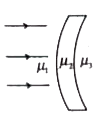Assertion A diverging lens (in air) cannot be made more diverging whatever be the medium we choose completely immerse the lens.
Reason The minimum refractive index of any medium is 1.
53
54
1615
32
The correct Answer is:A
(a) ∵ Refractive index of water with respect to air, anw=43
and Refarctive index of glass with respect to water, ang=anw×wng=43×108=53
Topper's Solved these Questions
- RAY OPTICSBOOK - DC PANDEY ENGLISHCHAPTER - RAY OPTICSEXERCISE - medical entrance special format question
23 Videos
- RAY OPTICSBOOK - DC PANDEY ENGLISHCHAPTER - RAY OPTICSEXERCISE - Medical entrance gallary
76 Videos
- RAY OPTICSBOOK - DC PANDEY ENGLISHCHAPTER - RAY OPTICSEXERCISE - Checkpoint 9.7
10 Videos
- NUCLEIBOOK - DC PANDEY ENGLISHCHAPTER - NUCLEIEXERCISE - C MADICAL ENTRANCES GALLERY
46 Videos
- REFLECTION OF LIGHTBOOK - DC PANDEY ENGLISHCHAPTER - REFLECTION OF LIGHTEXERCISE - Subjective
9 Videos
Similar Questions
Light is incident on the thin lens as shown in figure. The refractive index of the material of the lens is μ2. The radii of curvature of both the surfaces are R. The refractive index of the medium of left side is μ1, while that of right side is μ3. What is the focal length of the lens?

View SolutionA lens behaves as a converging lens in air and a diverging lens in water. The refractive index of the material is (refractive index of water =1.33)
View Solution
Knowledge Check
Assertion : A convex lens of glass (μ=1.5) behave as a diverging lens when immersed in carbon disulphinde of higher refractive index (μ=1.65).
Reason : A diverging lens is thinner in the middle and thicker at the edges.AIf both assertion and reason are true and reason is the correct explanation of assertion.BIf both assertion and reason are true and reason is not the correct explanation of assertion.CIf assertion is true but reason is false.DIf both assertion and reason are false.
A diverging lens is made of material with refractive index 1.3 and has identical concaves surfaces of radius 20cm. The lens is immersed in a transparent medium with refractive index 1.8.
(a) What is now the focal length of the lens?
(b) What is the minimum distance taht an immersed object must be from the lens so that a real image is formed?
View SolutionA thin convex lens of refractive index 1.5cm has 20cm focal length in air. If the lens in completely immersed in a liquid of refractive index. 1.6, then its focal length will be
View SolutionA thin convex lens which is made of glass (refractive index 1.5) has a focal length of 20 cm. It is now completely immersed in a transparent liquid having refractive index 1.75. Find the new focal length of the lens.
View SolutionAssertion : Newton's rings are formed in the reflected system. When the space between the lens and the glass plate is filled with a liquid of refractive index greater than that of glass, the central spot of the pattern is bright.
Reason : This is because the reflections in these cases will be from a denser to a rarer medium and the two interfering rays are reflected under similar conditions.
View SolutionA double convex lens has two surfaces of equal radii R and refractive index m=1.5, we have
View SolutionAssertion : When light passes from one medium to another of different density the only quantity which is unchanged is its wavelength .
Reason : The wavelength of light is not related to the refractive index of the medium .
View SolutionA lens is made of flint glass (refractive index =1.5). When the lens is immersed in a liquid of refractive index 1.25 , the focal length:
View Solution
